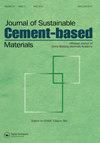Laminated stone-inspired multi-layer crystal structure reinforced bamboo scrap/magnesium oxychloride lightweight composites
IF 4.2
3区 工程技术
Q1 CONSTRUCTION & BUILDING TECHNOLOGY
Journal of Sustainable Cement-Based Materials
Pub Date : 2023-05-10
DOI:10.1080/21650373.2023.2210316
引用次数: 0
Abstract
Abstract Magnesium-based aerated cement has the characteristics of noncombustibility and nontoxicity compared with traditional organic aerated materials, realizing low-carbon manufacturing and energy saving in building construction. However, the pore walls of ordinary magnesium-based aerated cement are thin and brittle and can easily collapse under force, limiting its application in energy saving. This study aimed to obtain low-cost, low-energy, lightweight, high-strength, flame-retardant, and heat-insulating thermal insulation materials. Inspired by the formation process of stacked stones, calcium stearate was adsorbed on solid particles, stabilizing the pore and forming independent lumps of gel-state crystals in this study. At the same time, the hydrogen bonds of hydroxyethyl cellulose were used to chemically stitch the dispersed crystals to form a dense laminated structure. The interfacial compatibility between bamboo scraps and magnesium oxychloride improved the load transfer efficiency. The results showed that the strength-to-weight ratio of the composites increased 2.5 times, and the softening coefficient increased about 2 times. In comparison, the mechanical properties and thermal insulation properties of the composites far exceeded those of most thermal insulation materials, providing a theoretical basis for their use in the field of multifunctional building materials.受石材启发的多层晶体结构增强竹片/氯氧镁轻质复合材料
摘要镁基掺气水泥与传统有机掺气材料相比,具有不燃、无毒的特点,可实现建筑施工中的低碳制造和节能。然而,普通镁基充气水泥的孔壁薄而脆,在受力下容易坍塌,限制了其在节能方面的应用。本研究旨在获得低成本、低能耗、轻质、高强、阻燃、隔热的保温材料。受堆积的石头形成过程的启发,本研究将硬脂酸钙吸附在固体颗粒上,稳定孔隙,形成独立的凝胶态晶体块。同时,利用羟乙基纤维素的氢键将分散的晶体进行化学缝合,形成致密的层状结构。竹屑与氯氧镁的界面相容性提高了载荷传递效率。结果表明,复合材料的强重比提高了2.5倍,软化系数提高了约2倍。通过对比,复合材料的力学性能和保温性能远远超过大多数保温材料,为其在多功能建筑材料领域的应用提供了理论依据。
本文章由计算机程序翻译,如有差异,请以英文原文为准。
求助全文
约1分钟内获得全文
求助全文
来源期刊
CiteScore
6.60
自引率
15.90%
发文量
71
期刊介绍:
The Journal of Sustainable Cement-Based Materials aims to publish theoretical and applied researches on materials, products and structures that incorporate cement. The journal is a forum for discussion of research on manufacture, hydration and performance of cement-based materials; novel experimental techniques; the latest analytical and modelling methods; the examination and the diagnosis of real cement and concrete structures; and the potential for improved cement-based materials. The journal welcomes original research papers, major reviews, rapid communications and selected conference papers. The Journal of Sustainable Cement-Based Materials covers a wide range of topics within its subject category, including but are not limited to: • raw materials and manufacture of cement • mixing, rheology and hydration • admixtures • structural characteristics and performance of cement-based materials • characterisation techniques and modeling • use of fibre in cement based-materials • degradation and repair of cement-based materials • novel testing techniques and applications • waste management

 求助内容:
求助内容: 应助结果提醒方式:
应助结果提醒方式:


